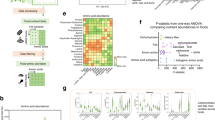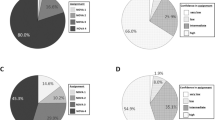Abstract
Background/Objectives:
Diet models based on goal programming (GP) are valuable tools in designing diets that comply with nutritional, palatability and cost constraints. Results derived from GP models are usually very sensitive to the type of achievement function that is chosen.
This paper aims to provide a methodological insight into several achievement functions. It describes the extended GP (EGP) achievement function, which enables the decision maker to use either a MinSum achievement function (which minimizes the sum of the unwanted deviations) or a MinMax achievement function (which minimizes the largest unwanted deviation), or a compromise between both. An additional advantage of EGP models is that from one set of data and weights multiple solutions can be obtained.
Subjects/Methods:
We use small numerical examples to illustrate the ‘mechanics’ of achievement functions. Then, the EGP achievement function is demonstrated on a diet problem with 144 foods, 19 nutrients and several types of palatability constraints, in which the nutritional constraints are modeled with fuzzy sets.
Results:
Choice of achievement function affects the results of diet models.
Conclusions:
MinSum achievement functions can give rise to solutions that are sensitive to weight changes, and that pile all unwanted deviations on a limited number of nutritional constraints. MinMax achievement functions spread the unwanted deviations as evenly as possible, but may create many (small) deviations. EGP comprises both types of achievement functions, as well as compromises between them. It can thus, from one data set, find a range of solutions with various properties.
This is a preview of subscription content, access via your institution
Access options
Subscribe to this journal
Receive 12 print issues and online access
$259.00 per year
only $21.58 per issue
Buy this article
- Purchase on Springer Link
- Instant access to full article PDF
Prices may be subject to local taxes which are calculated during checkout


Similar content being viewed by others
References
Buttriss JL, Briend A, Darmon N, Ferguson EL, Maillot M, Lluch A . Diet modelling: how it can inform the development of dietary recommendations and public health policy. Nutr Bull 2014; 39: 115–125.
Darmon N, Ferguson E, Briend A . Linear and nonlinear programming to optimize the nutrient density of a population's diet: an example based on diets of preschool children in rural Malawi. Am J Clin Nutr 2002; 75: 245–253.
Briend A, Darmon N, Ferguson E, Erhardt JG . Linear programming: a mathematical tool for analyzing and optimizing children's diets during the complementary feeding period. J Pediatr Gastroenterol Nutr 2003; 36: 12–22.
Thompson S, Gower R, Darmon N . LiveWell for Life. A balance of healthy and sustainable food choices for France, Spain, and Sweden 2013: http://livewellforlife.eu/livewell-plate/reports accessed 25 April 2014 WWF Report.
Anderson AM, Earle MD . Diet planning in the third world by linear and goal programming. J Operation Res Soc 1983; 34: 9–16.
Ferguson EL, Darmon N, Fahmida U, Fitriyanti S, Harper TB, Premachandra IM . Design of optimal food-based complementary feeding recommendations and identification of key "problem nutrients" using goal programming. J Nutr 2006; 136: 2399–2404.
Fletcher LR, Soden PM, Zinober ASI . Linear programming techniques for the construction of palatable human diets. J Operation Res Soc 1994; 45: 489–496.
Darmon N, Ferguson EL, Briend A . A cost constraint alone has adverse effects on food selection and nutrient density: an analysis of human diets by linear programming. J Nutr 2002; 132: 3764–3771.
Darmon N, Ferguson EL, Briend A . Impact of a cost constraint on nutritionally adequate food choices for French women: an analysis by linear programming. J Nutr Educ Behav 2006; 38: 82–90.
Maillot M, Vieux F, Amiot MJ, Darmon N . Individual diet modeling translates nutrient recommendations into realistic and individual-specific food choices. Am J Clin Nutr 2010; 91: 421–430.
Masset G, Monsivais P, Maillot M, Darmon N, Drewnowski A . Diet optimization methods can help translate dietary guidelines into a cancer prevention food plan. J Nutr 2009; 139: 1541–1548.
Jones D, Tamiz M . Practical Goal Programming. Springer Science+Business Media, LLC: Boston, MA, 2010.
Tamiz M, Jones D, Romero C . Goal programming for decision making: an overview of the current state-of-the-art. Eur J Operation Res 1998; 111: 569–581.
Romero C . Extended lexicographic goal programming: a unifying approach. Omega 2001; 29: 63–71.
Romero C . A general structure of achievement function for a goal programming model. Eur J Operation Res 2004; 153: 675–686.
Jones D . A practical weight sensitivity algorithm for goal and multiple objective programming. Eur J Operation Res 2011; 213: 238–245.
Brill ED Jr . The use of optimization models in public-sector planning. Manag Sci 1979; 25: 413–422.
Makowski D, Hendrix EMT, Van Ittersum MK, Rossing WAH . A framework to study nearly optimal solutions of linear programming models developed for agricultural land use exploration. Ecol Model 2000; 131: 65–77.
Makowski D, Hendrix EMT, Van Ittersum MK, Rossing WAH . Generation and presentation of nearly optimal solutions for mixed-integer linear programming, applied to a case in farming system design. Eur J Operation Res 2001; 132: 425–438.
Romero C, Tamiz M, Jones DF . Goal programming, compromise programming and reference point method formulations: linkages and utility interpretations. J Operation Res Soc 1998; 49: 986–991.
Claassen GDH, Hendriks THB, Hendrix EMT . Decision Science: Theory and Applications. Wageningen Academic Publishers: Wageningen, 2007.
Gedrich K, Hensel A, Binder I, Karg G . How optimal are computer-calculated optimal diets? Eur J Clin Nutr 1999; 53: 309–318.
Wirsam B, Hahn A, Uthus EO, Leitzmann C . Fuzzy sets and fuzzy decision making in nutrition. Eur J Clin Nutr 1997; 51: 286–296.
Wirsam B, Uthus EO . The use of fuzzy logic in nutrition. J Nutr 1996; 126: 2337S–2341S.
Yaghoobi MA, Tamiz M . A method for solving fuzzy goal programming problems based on MINMAX approach. Eur J Operation Res 2007; 177: 1580–1590.
Dantzig GB . On the significance of solving linear programming problems with some integer variables. Econometrica 1960; 28: 30–44.
Nordic council of Ministers. Nordic Recommendations 2012. Integrating Nutrition and Physical Activity, 5th edn. Copenhagen: Nordisk Ministerråd, 2014.
Health Council of the Netherlands Guidelines for a Healthy Diet 2006. Health Council of the Netherlands: The Hague, 2006.
Jones D, Jimenez M . Incorporating additional meta-objectives into the extended lexicographic goal programming framework. Eur J Operation Res 2013; 227: 343–349.
Carlson A, Lino M, Fungwe T . The Low-Cost, Moderate-Cost, and Liberal Food Plans. http://www.cnpp.usda.gov/Publications/FoodPlans/MiscPubs/FoodPlans2007AdminReport.pdf 2007 accessed on 25 April 2014: CNPP-20.
Gao X, Wilde PE, Lichtenstein AH, Tucker KL . The 2005 USDA food guide pyramid is associated with more adequate nutrient intakes within energy constraints than the 1992 pyramid. J Nutr 2006; 136: 1341–1346.
Cleveland LE, Escobar AJ, Lutz SM, Welsh SO . Method for identifying differences between existing food intake patterns and patterns that meet nutrition recommendations. J Am Diet Assoc 1993; 93: 556–563.
Bazaraa MS, Sherali HD, Shetty CM . Nonlinear Programming: Theory and Algorithms. Wiley: New York, 1993.
Acknowledgements
This research received no grant from any funding agency in the public, commercial or not-for profit sectors.
Author information
Authors and Affiliations
Corresponding author
Ethics declarations
Competing interests
The authors declare no conflict of interest.
Additional information
Supplementary Information accompanies this paper on European Journal of Clinical Nutrition website
Rights and permissions
About this article
Cite this article
Gerdessen, J., de Vries, J. Diet models with linear goal programming: impact of achievement functions. Eur J Clin Nutr 69, 1272–1278 (2015). https://doi.org/10.1038/ejcn.2015.56
Received:
Revised:
Accepted:
Published:
Issue Date:
DOI: https://doi.org/10.1038/ejcn.2015.56
This article is cited by
-
An extensive search algorithm to find feasible healthy menus for humans.
Operational Research (2022)
-
Using multiobjective optimization models to establish healthy diets in Spain following Mediterranean standards
Operational Research (2021)
-
Designing low-cost “heart healthy bread”: optimization using linear programing and 15-country comparison
BMC Nutrition (2016)



